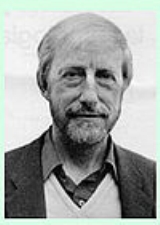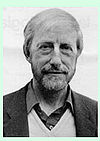
John Chris Jones
Encyclopedia

Designer
A designer is a person who designs. More formally, a designer is an agent that "specifies the structural properties of a design object". In practice, anyone who creates tangible or intangible objects, such as consumer products, processes, laws, games and graphics, is referred to as a...
. He was born in 1927, in Aberystwyth, Wales. He studied engineering
Engineering
Engineering is the discipline, art, skill and profession of acquiring and applying scientific, mathematical, economic, social, and practical knowledge, in order to design and build structures, machines, devices, systems, materials and processes that safely realize improvements to the lives of...
at the University of Cambridge
University of Cambridge
The University of Cambridge is a public research university located in Cambridge, United Kingdom. It is the second-oldest university in both the United Kingdom and the English-speaking world , and the seventh-oldest globally...
, and went on to work for AEI
Associated Electrical Industries
Associated Electrical Industries was a British holding company formed in 1928 through the merger of the British Thomson-Houston Company and Metropolitan-Vickers electrical engineering companies...
in Manchester
Manchester
Manchester is a city and metropolitan borough in Greater Manchester, England. According to the Office for National Statistics, the 2010 mid-year population estimate for Manchester was 498,800. Manchester lies within one of the UK's largest metropolitan areas, the metropolitan county of Greater...
, England. His 1970 book Design Methods is considered a major text in design
Design
Design as a noun informally refers to a plan or convention for the construction of an object or a system while “to design” refers to making this plan...
.
Collaborating with engineers, Jones advocated ergonomics
Ergonomics
Ergonomics is the study of designing equipment and devices that fit the human body, its movements, and its cognitive abilities.The International Ergonomics Association defines ergonomics as follows:...
and the consideration of user-centred issues not part of engineering
Engineering
Engineering is the discipline, art, skill and profession of acquiring and applying scientific, mathematical, economic, social, and practical knowledge, in order to design and build structures, machines, devices, systems, materials and processes that safely realize improvements to the lives of...
skills and attitudes at the time. When the results of his ergonomic studies of user behavior were not utilized by the firm's designers, Jones set about studying the design process being used. Jones was also frustrated with the superficiality of industrial design
Industrial design
Industrial design is the use of a combination of applied art and applied science to improve the aesthetics, ergonomics, and usability of a product, but it may also be used to improve the product's marketability and production...
at the time and become involved with ergonomics
Ergonomics
Ergonomics is the study of designing equipment and devices that fit the human body, its movements, and its cognitive abilities.The International Ergonomics Association defines ergonomics as follows:...
.
Design methods
Design methods
Design Methods is a broad area that focuses on:* Divergence – Exploring possibilities and constraints of inherited situations by applying critical thinking through qualitative and quantitative research methods to create new understanding toward better design solutions* Transformation – Redefining...
as an area was driven by:
- Inability to balance individual, group, societal, and ecological needs;
- Lack of purpose, order, and human scale;
- Aesthetic and functional failure in adapting to local physical and social environments;
- Development of materials and standardized components that were ill suited for use in any specific application;
- Creation of artifacts that people did not like
Jones wasn't actually addressing design
Design
Design as a noun informally refers to a plan or convention for the construction of an object or a system while “to design” refers to making this plan...
as presently conceived. He set out an entirely original philosophy of design—one that questioned the aims, goals and purposes of designing. He stated that one of the reasons why he focused on Design Methods was
- ". . . it's not another way of doing design, you see, it's a way of doing what designers don't do at all."
At the end of the 1950s he published an article "A Systematic Design Method" articulating ways to integrate ergonomic data into the engineering design process. His emerging ideas about Design Methods was to integrate both rationality
Rationality
In philosophy, rationality is the exercise of reason. It is the manner in which people derive conclusions when considering things deliberately. It also refers to the conformity of one's beliefs with one's reasons for belief, or with one's actions with one's reasons for action...
and intuition
Intuition (knowledge)
Intuition is the ability to acquire knowledge without inference or the use of reason. "The word 'intuition' comes from the Latin word 'intueri', which is often roughly translated as meaning 'to look inside'’ or 'to contemplate'." Intuition provides us with beliefs that we cannot necessarily justify...
—a common thread in the formalization of Design Methods and how it was interpreted by other groups.
He also realized that designers needed to move out of focusing on expression
Expression
Expression may refer to:Symbolic expression* Expression , a thought communicated by language* Expression , a finite combination of symbols that are well-formed according to applicable rules...
and modes of production and begin to address the definition of a problem to be solved. He commented that
- "the future job of a designer is to give substance to new ideas while taking away the physical and organizational foundations of old ones. In this situation, it is nonsense to think of designing as the satisfaction of existing requirements. New needs grow and old needs decay . . ."
Books
- Jones, John Christopher, Design Methods: seeds of human futures, John Wiley & Sons Ltd., London, 1970; 2nd edition, John Wiley & Sons Ltd., 1992
- Jones, John Christopher, Designing Designing (London: Architecture Design and Technology Press), 1991
- Jones, John Christopher, "The Internet and Everyone" (London: ellipsis London Ltd.), 2000

